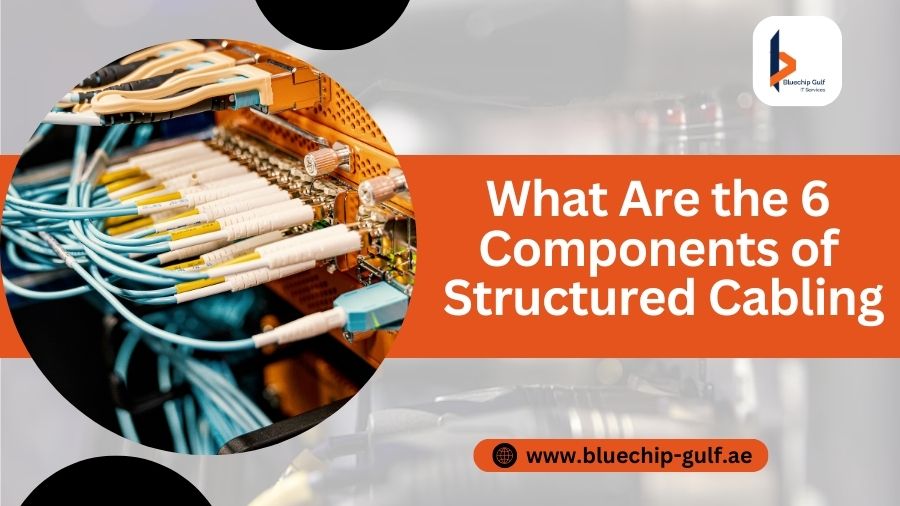
In current years, there has been a tremendous transformation in the landscape of cable systems. Gone are the days of two to four pairs of copper wires linked to main devices using basic components. The modern era has ushered in advanced connectivity solutions, capable of transporting high-speed data and voice signals seamlessly. These contemporary structured cabling systems are comprised of six essential components, each of which performs a pivotal role in enabling efficient and reliable network communication.
Understand the 6 Components of Structured Cabling
Structured cabling is a sophisticated network infrastructure that encompasses hardware and associated cables, designed to offer a versatile and forward-looking foundation for data communication. This system simplifies the management, troubleshooting, and tracking of its components, making it an efficient solution for various applications.
Apart from its aesthetic appeal, structured cabling offers the advantage of organized cabling and hardware. This organization simplifies the process of adding, modifying, or relocating components with minimal downtime. It ensures that your network remains adaptable to change, saving time and resources in the long run.
Structured cabling forms the backbone of modern connectivity, ensuring the efficient flow of data and communication within various premises. To gain a deeper understanding of this intricate system, it’s crucial to examine each of its six key components in detail –
- Entrance Facilities
- Entrance facilities are the designated points where external telecommunication services enter a building or premises through wall openings. This is where the connection from the telecom provider or local area network is established.
- The incoming service, often routed through a conduit, is connected to the devices and systems within the premises, whether it’s a room, building, or facility.
- Equipment Room
- The equipment room serves as the nerve center of the structured cabling system. It houses critical components such as servers, PBXs (Private Branch Exchanges), patch panels, network switches, and more.
- The connection between the entrance facilities and the various designated devices occurs within the equipment room.
- Because of the sensitivity and vital nature of the equipment, these rooms must be maintained in a specific condition. They should be dust-free and have controlled temperature and humidity levels.
- Manufacturers or vendors of the equipment often provide guidance on the ideal atmospheric conditions to ensure optimal device performance and longevity. Improperly maintained rooms can negatively impact equipment operation and lifespan.
- Backbone Cabling
- Also renowned as riser cabling, backbone cabling is typically installed on vertical channels or risers, connecting different floors or areas within a building.
- This type of cabling acts as the essential link between access aptitudes and telecommunication gadgets, between various equipment rooms, and among different carrier spaces.
- Cabling subsystems 2 and 3 make up the backbone cabling system.
- Telecommunications Room and Telecommunications Enclosure
- Telecommunications rooms (TRs) and telecommunications enclosures (TEs) are designated spaces within the structured cabling system. They are environmentally controlled areas.
- TEs represent dedicated rooms where hardware and backbone cables terminate, often housing patch panels and other essential equipment.
- TRs, on the other hand, maybe assigned sections within larger rooms, serving the same purpose. These spaces are used to connect various cables, including local cables, patch cords, and patch panels, creating a network of interconnected cables.
- Horizontal Cabling
- Horizontal cabling serves the vital role of delivering telecommunications resources to users’ workspaces.
- It extends from the user’s device or workstation to the nearest telecommunications room (TR).
- The maximum supported cable length for horizontal cabling is typically 295 feet, ensuring efficient connectivity within the workspace.
- Work Area
- The work area represents the final point of connection in the structured cabling system, bringing the network’s reach to the user’s immediate surroundings.
- It typically involves the connection from a wall outlet or jack to the user’s device, such as a computer, phone, or other network-connected equipment.
- This component bridges the gap between the structured cabling system and the end-users, facilitating seamless communication and data access.
Structured cabling, with its intricate web of components, plays a fundamental role in enabling modern communication and data exchange within a wide range of environments, from office buildings to data centers. Understanding these components in detail is essential for ensuring the efficiency, reliability, and scalability of the cabling system, ultimately contributing to seamless connectivity in our digital age.
What Makes Structured Cabling Important?
Structured cabling is the backbone of modern connectivity, and its importance cannot be overstated. Several key factors highlight its significance –
1. Reliability – Structured cabling service provides in Abu Dhabi a reliable network foundation. With well-organized cabling, you can count on consistent and uninterrupted data and voice communication, which is essential for business operations and everyday connectivity.
2. Scalability – As companies develop and their network requirements expand, structured cabling systems can be easily scaled up. This scalability confirms that your network can adapt to evolving requirements without the need for a complete overhaul.
3. Reduced Downtime – Efficiently managed cabling systems lead to reduced downtime. In case of maintenance or troubleshooting, organized cabling allows for quick and minimally disruptive interventions, ensuring that operations remain smooth.
4.Cost-Effectiveness – While there is an initial investment in structured cabling, its long-term cost-effectiveness is undeniable. A well-implemented system minimizes operational costs, reduces the need for frequent repairs, and avoids the expense of constant upgrades.
5.Future-Proofing – Structured cabling systems are created to last for many years. They can accommodate new technologies and higher bandwidth demands, providing a stable foundation for future innovations.
6.Aesthetics – Neat and organized cabling not only improves functionality but even contributes to the aesthetics of a space. A well-structured cabling system not only functions efficiently but also looks visually appealing.
In essence, structured cabling is the invisible force that maintains our contemporary world connected. It ensures the efficient flow of data and communication, supporting businesses, organizations, and individuals in our data-driven age. Its importance lies in its ability to provide reliable, scalable, and cost-effective connectivity, making it an indispensable component of our interconnected world.

